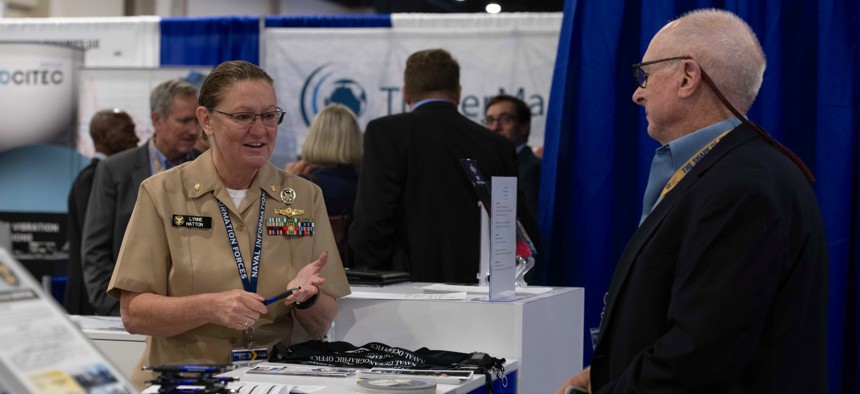
Lt. Cmdr. Lynne Hatton speaks with an attendee at the Naval Information Warfare booth during the Sea Air Space 2021 exposition. U.S. Navy / Mass Communication Specialist 2nd Class Almagissel Schuring
Defense Business Brief: Sea Air Space wrapup; Senators eye billions for defense in infrastructure bill; Lockheed CFO, Navy undersecretary retire; and more.
Thousands of people attended the Navy League’s Sea Air Space convention this week, the first in-person trade show since the beginning of the coronavirus pandemic, amid a national surge in delta variant infections. The show felt much larger in both attendance and the number of exhibits than the last one, held in 2019.
What does a major trade show held during a pandemic look like? Largely what it looked like before the pandemic—the only exceptions being a small number of masked attendees, a lot of hand sanitizer dispensers, and, occasionally, spaced-out seating in ballrooms.
Some companies limited the number of people allowed in their exhibit booths and required employees working those booths to wear masks. But in other areas, like that of Naval Sea Systems Command, presentations were packed with attendees standing shoulder to shoulder.
Face coverings were required for unvaccinated individuals and optional for vaccinated attendees, but, like most places these days, it’s an honor system.
The vast majority of the dark-suited or corporate-polo-wearing defense industry crowd went without facemasks, although by Wednesday, the final day of the show, it seemed there were more masks than on Monday or Tuesday. Overall, it appeared that less than 10 percent of attendees went with masks. (The Navy League offered masks to whoever wanted them).
The number of uniformed sailors, Marines, and coast guardsmen at this event is typically much lower than the Association of the U.S. Army’s annual October meeting in Washington or the Air Force Association’s September conference in National Harbor. A Navy League spokeswoman said attendance “exceeded our expectations,” but noted it doesn’t disclose specific numbers.
Why it matters: Companies and organizers of other conferences were watching closely to see how this week’s event played out. The spread of the more contagious delta variant is already leading to restrictions around the country. Prince George’s County, which includes National Harbor, on Thursday said it would reimpose an indoor mask mandate for vaccinated and unvaccinated individuals inside businesses.
For more of our Sea Air Space coverage, check out the links below.
Three Senate Republicans are pushing to add $50 billion in defense projects into the bipartisan infrastructure bill being debated in Congress, Politico reports. The money would go toward the Navy’s public shipyards ($21 billion), private shipyards ($4 billion); with much of the rest going to base infrastructure projects around the country. Of note: $2.5 billion would go toward installing 5G wireless technology at defense installations.
Weekend reading: Todd Harrison at the Center for Strategic and International Studies takes a look at Joint All-Domain Command and Control in the first of a two-part series about the U.S. military’s battle networks. “[T]his paper examines the importance of battle networks to modern military operations and presents a framework of five functional elements that make up a battle network,” he writes. “This framework provides a common basis for conceptualizing and comparing existing systems and proposed new capabilities in terms of how they contribute to JADC2.” Read it here.
Making Moves
Ken Possenriede announced Tuesday he would immediately retire as Lockheed Martin’s chief financial officer. John Mollard, the company’s treasurer, has been appointed acting CFO.
Back at the Pentagon, Gregory Kausner, executive director for International Cooperation, assumed the duties of undersecretary for acquisition and sustainment. Still no word on the Biden administration nominee after Defense Innovation Unit head Michael Brown took himself out the running last month in the wake of an inspector general investigation.
Paul Cramer, principal deputy assistant secretary for sustainment, assumed the duties of deputy undersecretary for acquisition and sustainment.
Lastly, James “Hondo” Geurts, who has been serving as the fill-in undersecretary of the Navy since February after being the head of Navy acquisition during the Trump administration, announced he would retire from government service later this month. No replacement has been named.
 From Defense One
From Defense One
US Air Force, Venture Firms Make $60 Million Bet on Hypersonic Aircraft Startup // Marcus Weisgerber
The deal calls for Georgia-based Hermeus to accelerate development of reusable test aircraft.
New Marine One Expected to Start Flying President Biden Soon // Marcus Weisgerber
The White House and the Marine Corps are developing commissioning plans.
Top Admiral: Defense Firms Are Lobbying Against the Weapons the US Navy Needs // Marcus Weisgerber
Adm. Mike Gilday also accused companies of slow-rolling ship repair.
Data Friendliness Will Make Some Weapons More Valuable, Says Northrop CTO // Patrick Tucker
Future weapons will have more value if they connect more easily to the network right out of the box, but that's not the way military weapons or networks are made today.
The US Navy Is Reversing Its Fighter-Jet Design Philosophy // Marcus Weisgerber
NavAir commander says the next-gen plane will be designed around certain cutting-edge technologies.
Can We Spot Illegal Fishing Fleets from Space? // Patrick Tucker
The Defense Innovation Unit is offering prizes for using satellite-mounted radar to fight a growing national-security problem.
In the Newly Noisy Arctic, Underwater Operations Are Getting Harder // Caitlin M. Kenney
Less ice means more ships, which means more problems for sonar operators and their skippers.
A New Bill Seeks to Patch the Flaws in the Arms Export Control Act // A. Trevor Thrall and Jordan Cohen
The proposed legislation would help Congress regain a measure of sway over weapons sales.




